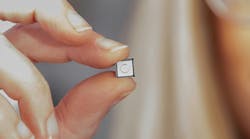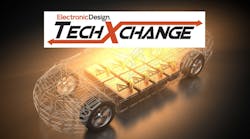Tiny Battery-Management SoC is Powered by AI
Lithium-ion (Li-ion) batteries have long been the gold standard in the electronics industry. They have a very high energy density and moderate self-discharge rate. They can also tolerate thousands of charge-discharge cycles before breaking down. While these power-handling properties give them the edge in electric vehicles (EVs) and other markets , Li-ion batteries can be unforgiving—and even dangerous. They must be closely monitored by a battery-management system (BMS) to safely and reliably wring out as much power as possible.
To measure the ins and outs of these batteries even more accurately in real-time, Eatron Technologies has rolled out a BMS-on-chip (SoC) co-developed with U.S.-based AI startup Syntiant for light mobility, industrial, and consumer devices.
Eatron embedded its intelligent BMS software into Syntiant’s neural decision processor (NDP) so that it can continuously deliver accurate and robust cell-level assessments of remaining charge and other facets of the battery. Eatron said the NDP120 can run its latest AI models directly on the device, wringing out up to 10% more useful power without changing the chemistry of the battery cells or the construction of the larger pack.
The AI SoC can also run predictive diagnostics, including lithium plating detection, on the edge. By gaining more insights into the battery’s internal state, it’s able to identify potential issues before they cause failures or permanently impair its performance. According to Eatron, the BMS software can deliver prognostics such as overall health, aging trajectory, and remaining useful life prediction to increase the battery’s useful life by as much as 25%.
>>Check out the TechXchange and Library Series for similar articles and videos
Said Eatron’s chief product delivery officer Amedeo Bianchimano, “With AI-BMS-on-chip, we will enable any battery-powered application to be deployed in the millions in complete safety and getting the most energy out of the battery.”
BMS: The Backbone of Battery-Powered Devices
In general, the BMS is used to monitor and control the state of charge (SOC) and state of health (SOH) of the battery. But because the charging and discharging are the result of complex chemical, electrical, and physical interactions, estimating them accurately isn’t easy. The other issue is that neither of these metrics be measured directly. Instead, they must be estimated by tracking the internal state of the battery’s cells.
The SOC is determined by tracking the voltage and current flowing in and out of the battery cells along with impedance and other characteristics. The battery cells not only react to the constantly shifting conditions around it, but they invariably lose storage capacity due to the stress of repeated charging and discharging.
The SOH is based on most of the same factors as SOC. However, it also considers battery aging, the number of charging and discharge cycles it has experienced, and the temperatures it has been exposed to historically.
The battery itself is monitored by current, voltage and temperature sensors both at the cell and pack level. In many cases, it runs through battery-management ICs that use analog-to-digital converters (ADCs) to sense voltage and coordinate it with current (measured with current sensors or indirectly through coulomb counting) and temperature. These analog ICs integrate cell balancing and isolated communications to the MCU at the heart of the BMS, which uses feedback from the battery to adjust the charging and depletion of the battery.
The BMS also needs to understand the ins and outs of the battery to reduce risks and safety hazards. Overcharging or undercharging the battery’s cells may damage their internal structure, too, leading to premature charge termination and even a reduction in its useful lifespan. One of the main risks associated with Li-ion batteries is thermal runaway. If the battery cells are damaged, they can heat up uncontrollably and erupt in flames.
The BMS’s other role involves adjusting for temperature fluctuations inside the battery pack—and out. Exposure to heat and cold can result in large variances in a battery’s overall performance and lifespan.
Is AI the Key to the Future of Battery Management?
The BMS needs to carefully measure the remaining charge of the battery so that it can keep the SOC within the safe operating area (SOA), which sets the upper and lower limits for charging and discharging the battery.
Since it doesn’t directly measure currents, voltages, and temperatures of the battery, the Eatron chip is not technically a battery-management IC. Instead, it runs Eatron’s intelligent software layer (ISL) to process all of the data from the battery, serving as more of a co-processor for the BMS.
“The flexibility and capability of Eatron’s ISL is what sets it apart,” said CEO Umut Genc, adding that it uses AI “to maximize improvements in diagnostics and assessments regarding remaining useful life, state of charge, health, energy, and power.
He added that its unique algorithms are a difference maker. Eatron said its software is highly accurate throughout the lifespan of the battery and under a wide temperature range. By using its physics-based cell models, the IC can accurately chart the battery’s remaining charge to within 1%, specifically for the lithium-iron phosphate (LFP) and nickel-manganese cobalt (NMC) formulations widely used in high-voltage EV batteries, where Eatron is also targeting its software. Genc said that compares to industry benchmarks of about ±3%.
Since overcharging or undercharging battery cells can cause permanent harm, the BMS rarely replenishes them to their full capacity and it never completely drains them, keeping the SOC within a generally tight SOA. But if the BMS could estimate the remaining charge more accurately, it can expand the safe operating zone. “As a result of this more accurate picture of a battery’s state, we can typically unlock 10% more energy from it,” said Genc.
Eatron said it uses AI models to accurately calculate the SOH to within 2%. Using a more accurate prediction of the battery’s aging, the BMS can extend the battery’s useful lifespan, Genc told Electronic Design.
Bringing AI-Based Battery Management Out to the Edge
Eatron said it worked closely with Syntiant from 2022 to adapt the AI models inside its battery-management software to fit inside its sub-1-mW AI accelerator, which is based on its proprietary tensor processor core.
The NDP120 was first designed to run sensor fusion and “always-on” machine-learning models that can identify specific sounds or phrases such as “OK, Google” and then shake the larger system out of standby. It adds a programmable DSP and Arm Cortex-M0 CPU for system management in a 3.1- × 2.5-mm WLBGA package. While it lacks the huge amounts of memory required to handle the largest AI models with tens of billions of parameters, it contains enough on-chip memory to run compact models of up to several million.
Eatron said the power-sipping AI chip can deliver real-time battery management and diagnostics directly on the device rather than relying on the cloud, thus reducing latency, power consumption, and system costs.
According to Genc, Eatron’s ISL will operate both on the edge and in the cloud, and it “can be implemented on top of an existing battery-management system—it is, after all, a layer and sits above proprietary systems.”
Accordingly, Eatron said the SoC is a “plug-and-play solution” that can be integrated quickly and easily into existing systems. Customers can use its development tools to adapt it for specific applications, including electric bicycles and scooters to portable energy storage and battery-powered consumer robots. It contains a wide range of interfaces, including quad SPI and I2C bus, to interact with the MCU inside the BMS and the analog ICs that measure voltages, currents, and temperatures in the battery cells.



